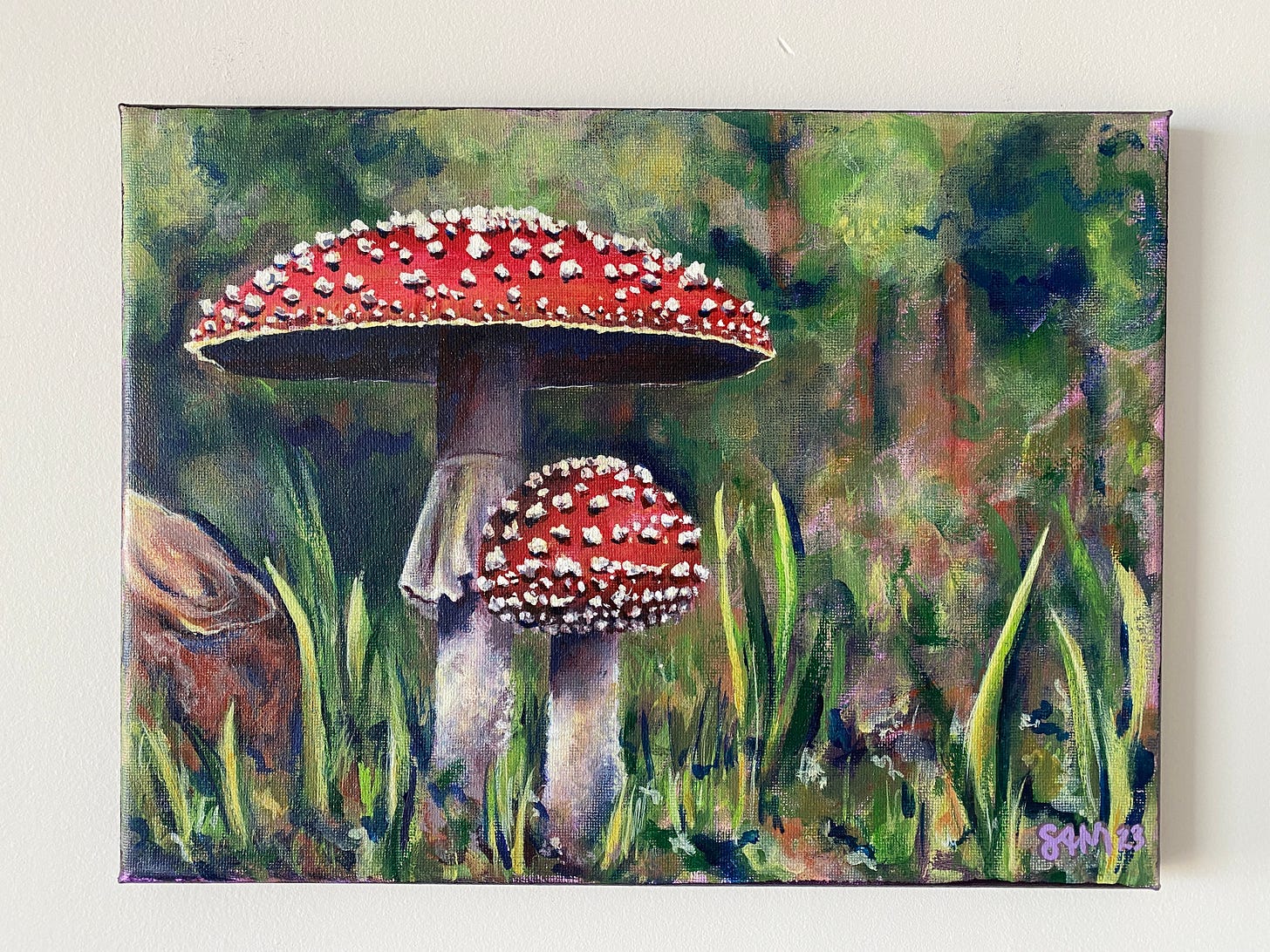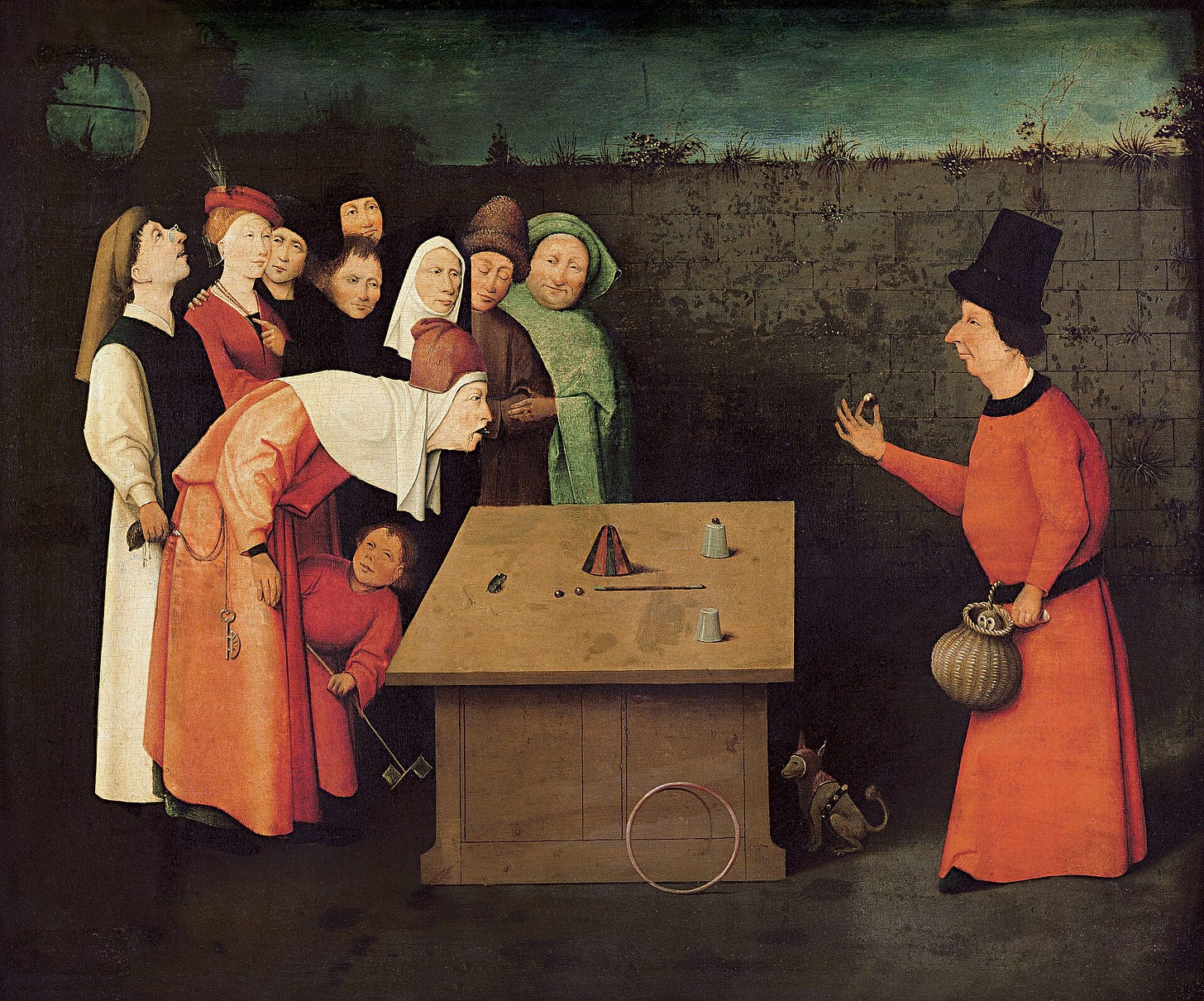These Are My Cups & These Are My Balls!
Illusions, the oldest trick in the book, and why you should delight in being fooled.

Hello, my stars.
First of all, I am sorry for the delay this week! I was in Colorado on a trip with my bestie, Erin, sipping water from natural springs, sampling craft beer from local breweries, and enjoying the skin-tingling sensations of sauna/cold plunges. We share a deep love of magic (the sleight of hand variety), so her aunt treated us to tickets for the “Impossible Things” show at Cosmo’s Magic Theater in Colorado Springs.
Cosmo is a brilliant storytelling and illusionist, totally at ease in front of the crowd. I truly cannot overstate how much we enjoyed our time at the theater, chatting with him before the show about our favorite magicians and watching him perform for a packed house. It turned out to be a highlight of the trip and inspired me to write a bit about what makes me so passionate about magic tricks and practitioners.

There are multiple types of magic, of course. Case in point, Wikipedia separates magic (supernatural) from magic (illusion). Today I am going to talk about the latter, although I am a believer in both. If you ask Google to define “magic,” the top result is “the power of apparently influencing the course of events by using mysterious or supernatural forces” (italics are my own). There is a fine line between a con artist and a magician (mainly, how they gain your trust and what they do with it), and watching well-executed magic tricks can bring out some intense emotions.
As a lifelong magic-lover, it always catches me off guard when people express repulsion or blanket distaste towards magicians. The fact remains, some people really hate magic. They view every trick as a challenge to be won and every sleight of hand as an insult to their intelligence.
Magician Nate Staniforth considers this type of person in his book, Here Is Real Magic:
The anger—and I do believe it is anger—toward the modern magician comes from the way even a simple magic trick done well can reach uninvited into the deepest hopes of a person. Sometimes this can be an uncomfortable reminder. People have hard lives, and something like magic that promises a moment of real joy or even a new way of seeing the world threatens to unseat whatever insulation they have managed to erect between themselves and that hardness, whether it’s cynicism, nihilism, escapism, or elitism. The cultural resentment toward magic comes from the sadness found in the space between the universal human longing to believe in magic and the overwhelming evidence all around us that there is no such thing. It’s not that a modern audience doesn’t want magic. It’s that they want it so badly but have already decided it’s not out there, and dislike being told that maybe they were looking in the wrong place.
What type of person despises magic? Do they have traits in common with one another? It turns out they do, and it isn’t a nice list. Diving a bit deeper into the psyche of these audience members, a 2023 study published in Psychology of Aesthetics, Creativity, and the Arts concluded that:
…people who hated magic were marked by (a) lower openness to experience and lower awe-proneness; (b) higher dogmatism, intolerance of uncertainty, and personal need for structure; and (c) higher socially aversive traits, such as lower agreeableness, greater interpersonal dominance, and higher psychopathy.
I don’t know about you, but lower awe-proneness is the complete opposite of what I am cultivating in my life. I want to be flexible, tolerant, and wide open to the world and all of the wonder waiting within it. Still, achieving this evolved state is often easier said than done, and it can be extra hard to relax in a charged setting like a magic show.
That’s why, the best magicians (in my opinion), kick off their routines by directly or indirectly acknowledging the fact that these are, in fact, illusions. It can come in the form of an explicit disclosure, i.e. the magician reminds you that everything you are about to see is an illusion they have practiced for years to master, or in a more subtle way, i.e. opening the show with a trick the entire audience does alongside the magician. Cosmo’s show opened in this manner, with a trick that I won’t spoil but will say involved us tearing and tossing playing cards all over the theater. In that moment, even though we didn’t know the exact method, we all became magicians. Ready to be delighted and willingly deceived, we settled into our seats.
Much of Cosmo’s performance that evening centered around the “oldest trick in the book” - the cups and balls (folded in with stories about his professional journey and some hilarious “balls” jokes). Dating back almost 2000 years, this illusion is represented in artwork and texts from around the world (some even speculate that it was practiced in ancient Egypt, but I couldn't confirm in my research). If you want to learn about the method behind the cups and balls, you can watch Penn and Teller do their version of the trick with clear cups.

In this video, Cosmo’s mentor, Dr. Dai Vernon (“The Professor”) performs the cups and balls trick at age 78 (you can also watch him do it at age 81). The Professor believed every movement in a trick should look as natural as possible and the audience should always be allowed to inspect the props. Master magicians like the Professor are experts at directing our attention, at bringing us along on a journey, at stewarding our trust and emotions, at guiding and (consensually) exploiting the limits of human perception.
These are precisely the same skills honed by painters and other artists.
One of the reasons I like working in traditional two-dimensional art is that the materials are as simple as a deck of playing cards or cups and balls. Fabric and paint, paper and pencil. It is all about how I use those simple things to create the illusion of form, perspective, and narrative.
If I gave you my paints and brushes and let you examine them, do you think you could deduce the exact way I made a mushroom painting? Would it add to your appreciation of the art or detract from it? What is gained or lost when we focus on dissecting the illusion instead of savoring it?
I do think it is important for the illusion in art to be explicit. You should know that it is paint, even as your brain tells you that is a real mushroom you could reach out and pluck. You should know that a photographer used complicated and expensive computer programs to alter their image. You should know that is an actor on stage, dressed in a costume or wielding a puppet. And, I think, you should be more amazed because of that knowledge. Should thrill in the gap between what your eyes are telling you and what your brain knows to be true.
As Penn Jillette said during Shin Lim’s first appearance on Fool Us, “The idea of doing card tricks which, at their core are really silly, really seriously and really really importantly is wonderful.” I’d like to expand this statement to say that the idea of doing anything silly in a really serious and important way is wonderful. Maybe that is part of the reason I like to inject whimsy, humor, and raunchiness into my art. It heightens the tension between the “seriousness” of painting as an art form and the delightful trick of applying pigment onto fabric to reveal a brightly colored mushroom.


When a Vanity Fair interviewer asked Penn whether the end goal of magic is to fool someone, he replied:
What’s the end goal for any work of art? The answer is it’s not one thing. In almost every work of art there is on one level—and this is the level at which magic is, I think, the most fundamental—at which you must amaze the audience. When you’re an actor, you must, for the moment you’re there, convince the audience that you are possessed by the spirit of this character. And there is a level in which you go, “Wow, I really thought for that moment, that the character onstage was Hamlet.” That amazement is the bottom line of any work of art.
So, this week, I hope you find something that amazes you. Something that cracks your heart open to awe. Something that allows you to steep in wonder, both confounded and delighted. I’ll be back next week with another magical edition of the Column of Creation, in the meantime, drop a link to something awe-inspiring in the comments if you want to share!
XOXO,
Sam ✨




Do you remember all the magic tricks that I used to do? My favorite was the cups n balls trick. As a teacher, I always had a magic trick on my pocket to wow the kids and convince them that I had super powers!!!